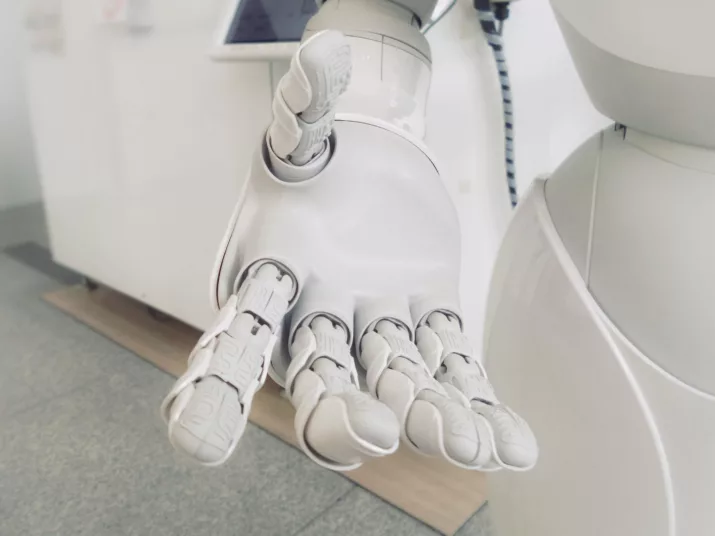
Photo: Possessed Photography on Unsplash
EIGHT REASONS WHY ROBOTICS STANDS ON THE VERGE OF MAJOR DEVELOPMENTS
Robots are no longer simple, static machines limited in their capabilities and their range of tasks. They have evolved into complex, interconnected and increasingly intelligent systems. And their development is striding forward: in the near future, crucial progress can be expected in the field of robotics. The technological conditions for this have never been better than now. Robot developer Gill A. Pratt, for example, is convinced of it. [1]

Photo: Possessed Photography on Unsplash
According to Pratt, lots of new developments in the tech sector have been benefiting robotics research. For example, we are currently seeing enormous progress in the fields of data storage, wireless communications, and battery and computing power. Pratt has identified a total of eight technological drivers whose interaction is proving favourable for robotics. Another two important technological developments are “cloud robotics” and “deep learning”. Let us introduce them to you.
EIGHT TECHNOLOGICAL DRIVERS FOR THE DEVELOPMENT OF ROBOTICS
1. COMPUTING POWER I: STRONG MACHINES
Since the very earliest days of information technology (IT), the performance of computers has been continuously improving and developing. In addition, the associated hardware – computer chips and transistors – has become smaller and smaller. In the meantime, the latter has shrunk to the size of a few nanometres. Just to put this in context: a sheet of paper is typically 100,000 nanometres thick. [2]
2. COMPUTING POWER II: GLOBAL PERFORMANCE
What applies to individual devices, naturally has implications too for computing performance as a whole: taken together, the computing power of all devices around the globe would add up to a figure whose sheer size is almost unimaginable. In part, this is due to the millions of high-performance servers operated by internet companies around the globe. How does that benefit robotics? For instance, it enables numerous mathematical calculations to be split into parallel processes and hence to be performed faster.
3. DESIGN IS MORE THAN OPTICS
Design is important. And this is true for robots too. Design, in this context, does not refer merely to outward appearance. In many cases, robots require highly specialised components that need to be specifically designed and manufactured at feasible prices. Computer-based design tools and manufacturing tools, such as those used in 3D printing, are extremely useful is this regard. The further development of these technologies is opening up many new possibilities.
4. MEANS OF ENERGY STORAGE
As robots have become more mobile, their energy supply has become ever more important. For a long time, the quality and durability of batteries left much to be desired. But since the advance of mobile devices and the development of e-mobility, researchers have been pushing ahead at full-steam in the area of energy storage. This could improve the energy supply of mobile robots too. True, standard lithium batteries are still less powerful than hydrocarbon fuels such as gasoline, sugar or fats. But they are catching up. And then there is a relatively new technology involving so-called supercapacitors, which charge and discharge much faster than normal batteries and can be recharged hundreds – or even thousands – of times. So far, however, their storage capacity still leaves much to be desired. In addition, researchers are working on the development of ecofriendly alternatives.
5. MORE PERFORMANCE WITH LESS ELECTRICITY
More energy performance for less money – sounds simple, but still requires a lot of research and development, including in the field of circuits and semiconductors, which together form the basis of computer chips. For example, new and more powerful compound semiconductors have recently been developed that can help make electronic devices – and therefore robots too – more efficient.
6. PREVIOUSLY A SINGLE DEVICE, NOW NETWORKED
In the old days, robots were self-contained systems. Each update had to be developed and installed individually, which was often a time-consuming and costly affair. Powerful wireless communication enables devices to be centrally maintained and updated. Controlling them has become easier too. With these changes, robots will be able to communicate wirelessly and faster than ever.
7. INTERNET ACCESS IS KEY
Internet use continues to grow. The so-called Cisco Visual Networking Index [3] predicts that by 2022 every person on the planet will use an average of three Internet-connected devices. Networked communication and interaction will therefore continue to increase. This also means that the storage capacity of individual robots will no longer be so decisive, whereas access to the Internet and the data available there will gain in importance.
8. BIG DATA FOR EVERYONE
Information is important – the more comprehensive, the better. But how can large bulks of data be stored and, in addition, be made available to robotic systems quickly and flexibly? Solutions could be provided in the future, for example, by the entertainment industry – keyword “film streaming” – and social media.
THE (SO FAR UNRIVALLED) ROLE MODEL IS US
Will robots in the future increasingly emulate the ways our human brain functions? Will they, at some point, even be able to imitate human thinking? This point has not yet been reached. Robots are still unable to reproduce many of the brain’s functions, such as storing and retrieving motor memories and personal memories, translating acquired skills to other fields, or arriving at their own knowledge-based conclusions.
Nevertheless, technological developments indicate that much has been happening in this field: for example, deep learning (see text box) is contributing to the reproduction and automatic processing of previously acquired knowledge. In this way, robots are getting better and better at learning how to find their way around in complex reality. Just like us.
[1] Gill A. Pratt, Is a Cambrian Explosion Coming for Robots, Journal of Economic Perspectives, S. 51-60
[2] Gill A. Pratt, Is a Cambrian Explosion Coming for Robots, S. 53
[3] Cisco Visual Networking Index: Forecast and Trends, 2017–2022 White Paper
[4] Gill A. Pratt, Is a Cambrian Explosion Coming for Robots, S.52